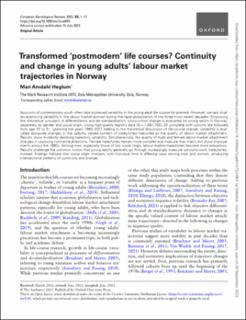| dc.description.abstract | Accounts of contemporary youth often take increased variability in the young adult life course for granted. However, we lack stud- ies examining variability in the labour market domain during the rapid globalization of the three most recent decades. Employing the theoretical concepts of differentiation and de-standardization, cross-cohort change is evaluated for young adults in Norway, separately by gender and social origin. Using high-quality registry data (N = 1,081,702), 20 complete birth cohorts are followed from age 22 to 31, spanning the years 1993–2017. Adding to the theoretical discussion of life-course change, variability is eval- uated alongside changes in the specific valued content of trajectories—denoted as the quality of labour market attachment. Results show modestly declining trajectory variability. Simultaneously, the quality of male and female labour market attachment changes in opposing normative directions. Female trajectories remain more complex and insecure than men’s but show improve- ments across the 1990s. Among men, especially those of low social origin, labour market trajectories become more precarious. Results challenge the common notion that young adults generally go through increasingly insecure school-to-work trajectories. Instead, findings indicate that social origin interacts with historical time in differing ways among men and women, producing intersectional patterns of continuity and change. | en_US |

